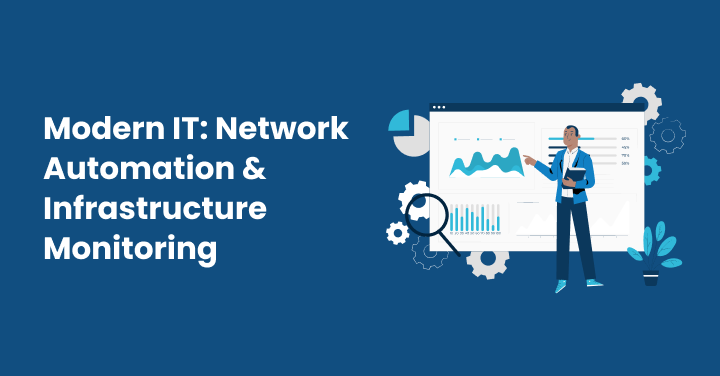The future of IT hinges on the ability to manage intricate multi-cloud environments. The linchpin of this heavy-duty task is network automation. Like an orchestra conductor, network automation ensures that each cloud platform plays its part harmoniously. The critical role of network automation in managing the complexities of multi-cloud environments cannot be overstated.
For instance, a common scenario involves utilizing Microsoft Azure for disaster recovery, Google Cloud Platform for development and testing, and AWS for data storage, each with its unique strengths and optimal use cases.
Managing multiple clouds can be difficult due to security concerns, compatibility issues, and efficient governance requirements. Businesses embarking on a multi-cloud journey must understand these compromises.
In this blog, we will explore the significance of network automation and how to leverage it.
The Need for Network Automation
Managing disparate networks becomes more difficult as businesses embrace multi-cloud strategies. Without network automation, operational costs soar, and agility falls. Hence, the key is network automation.
Key Facts:
- The global network automation market is projected to grow at 23.15% compounded annually in the next 10 years, from an estimated USD 5.41 billion in 2024 to approximately USD 43.40 billion by 2034.
- Deployment preferences currently favor on-premise solutions, which held 56% market share in 2023. This signifies that most users prefer to deploy network automation solutions on their premises, rather than using cloud-based solutions.
- Larger organizations dominated market revenues, comprising 64% in 2023. Larger organizations typically have more complex networks and a greater need for automation to manage their operations efficiently.
The function of network automation in contemporary network infrastructure management accounts for its value. Automation speeds up network operations like provisioning, configuration, and management, minimizes downtime, and lowers human error, especially in complex cloud networks. It can also significantly speed up the deployment of configuration changes across numerous devices, ensuring network stability and minimizing downtime.
Let’s look into the possible challenges in adopting network automation.
Challenges of Managing Multi-Cloud Networks Manually
According to recent Gartner research, approximately 81% of businesses have already adopted two or more cloud providers. Managing multi-cloud infrastructure presents a complex ecosystem where even seasoned IT professionals can be overwhelmed.
Some common challenges are:
1. Navigating Diverse Cloud Platforms
Every cloud provider designs its ecosystem uniquely. Amazon Web Services (AWS) relies heavily on a service-oriented architecture with more than 200 offerings. Microsoft Azure is structured around resource groups and subscription models, whereas Google Cloud Platform (GCP) organizes resources into projects and folders. This divergence adds substantial cognitive load for IT teams, increasing the likelihood of errors. Platform-specific nuances further complicate management.
2. Operational Silos and Limited Visibility
87% of technology leaders say multi-cloud complexity makes it more difficult to deliver outstanding customer experiences, and 84% say it makes applications more difficult to protect. Each cloud platform offers monitoring tools designed specifically for its ecosystem—AWS CloudWatch, Azure Monitor, and Google Cloud Monitoring—but these tools rarely integrate seamlessly. Consequently, visibility gaps appear, creating critical blind spots in overall infrastructure health.
3. Security Inconsistencies Across Clouds
27% of organizations have experienced a security incident in their public cloud infrastructure within the last 12 months. Inconsistent security policies across different cloud platforms pose significant risks. Differences extend deeper into identity and access management. AWS Identity and Access Management (IAM), Azure Active Directory (AD), and Google Cloud IAM have varying frameworks.
4. Cost Management and Financial Unpredictability
Some stats:
- 84% of businesses believe managing cloud spend is the top cloud challenge for organizations today.
- About 30% of cloud spend is wasted.
- 94% of enterprises are overspending in the cloud.
- Companies average 23% over budget on cloud spending and estimate that 30 percent of their outlays are wasted.
These numbers signify financial unpredictability that adds another layer of complexity to multi-cloud management.
Most overspending is typically due to idle or underutilized resources, unnecessarily high resource provisioning, or overlooked opportunities for reserved instance purchases.
Manual Processes: Human errors are bound to happen when they have to keep pace with the ever-evolving cloud settings. Automation is crucial for reducing human error and improving efficiency.
Why Automation Is the Only Practical Solution
At a small scale, manually managing cloud networks might seem feasible. But as businesses grow, so do their network demands. More applications, more users, more data—without automation, keeping up becomes impossible.
Network automation enables organizations to stay ahead of operational challenges, optimize resources, and reduce security risks without relying on manual intervention. It shifts IT teams from reactive to proactive, ensuring that the infrastructure keeps pace with business needs rather than becoming a bottleneck.
Benefits of Network Automation in Multi-Cloud
It will undoubtedly result in improved network infrastructure, focusing on performance enhancement. Creating and sustaining an effective hybrid cloud IT strategy has the potential to help your company introduce new goods and generate income. You will probably stick with a single cloud vendor’s technology and become an expert only in using their native tools and services if your in-house IT capabilities are limited. Confidence in reaping the full benefits of switching to a multi-cloud strategy can grow rapidly when access to IT skills that can cover the entire spectrum of all cloud providers is more widespread.
1. Enhances the Speed of Network Operations
A better multi-cloud forum will lead to in-depth network operations without any challenges of lagging speed and lousy loadings. Because network automation systems operate more efficiently, they will help businesses reach their objectives more quickly. They will lower the business’s expenses by streamlining procedures, reducing resources, and optimizing software for better work.
2. Enhanced Network Reliability and Stability
Automated networks will generate more precise data for analysis. You will be able to see the network more clearly and better understand its operation. Consequently, you will gain fresh perspectives to aid in strategic business planning.
3. Scalability and Flexibility
By automating network operations, an enterprise will have more scalable solutions and flexibility in managing and monitoring its data and other crucial day-to-day activities. It will save a lot of money and time, with reduced human errors in managing multi-cloud forums.
Key Technologies and Approaches for Network Automation
Network configuration management is a challenging task. And we understand. An organization has a lot to manage if its IT infrastructure is dispersed across AWS (for customer analytics), Google Cloud (for AI recommendation), and Azure (for inventory management).
But the network automation software here can be of great help, according to Slurp’it, especially for intricate, multi-cloud networks. Have you ever wondered how? Let’s dive in and understand the various technologies that can boost the whole automation part!
There are a variety of technologies that can assist an efficient network system with improved security and other management operations. Some of them are mentioned below:
Infrastructure as Code (IaC)
Infrastructure as code (IaC) is the ability to provision and support your computer infrastructure using code instead of manual processes and configurations. Numerous infrastructure elements, such as operating systems, database connections, and storage, are necessary for any application environment. Developers must regularly set up, update, and maintain the infrastructure to develop, test, and release applications.
Software-Defined Networking (SDN)
SDN changes how data moves through conventional networks managed by hardware (such as switches and routers) by moving the decision-making to a central software system. To do this, the data plane—which carries packets to their intended location—is separated from the control plane, which decides where traffic is routed.
This model differs from traditional networks, which regulate network traffic using specialized hardware devices (such as switches and routers). SDN can use software to build and manage a virtual network or manage conventional hardware. Software-defined networking offers a new method of managing data packet routing via a centralized server. At the same time, network virtualization enables enterprises to divide various virtual networks within a single physical network or to link devices on different physical networks to create a single virtual network.
Application Programming Interfaces (APIs)
APIs ease out and simplify software and application development by allowing developers to incorporate data, services, and capabilities from other applications rather than starting from scratch. Furthermore, APIs give application owners access to an easy, safe way to make their application data and functions available to departments within their organization.
Network Configuration Management (NCM)
It adheres to the process of containing all the components of network automation. The network administrator uses the network configuration management database to decide what to do when a network needs to be repaired, modified, expanded, or upgraded. This database contains information about the default settings, programs, versions, and updates installed in network computers, as well as the locations and Internet Protocol or network addresses of all hardware devices.
Intent-Based Networking (IBN)
IBN is a way to align business goals with network infrastructure management. This network management approach uses AI and ML to automate tasks across the network to achieve a specific goal.
How to Implement?
Start Small
Diving headfirst into network automation without a clear plan is like setting sail without a compass; it might end up somewhere, but it’s unlikely to be your destination!
Before you begin, it’s crucial to get your ducks in a row:
- What do you want to achieve? Do you want to free your team from repetitive tasks, boost network performance, tighten security, or roll out new features?
- How will you know if you’re successful? You need to establish clear metrics to track your progress.
- What resources do you need to make it happen? This includes both people and technology.
Security and Compliance
Upgrading your infrastructure is excellent, but don’t forget: with great power comes great responsibility—and more significant risks. We can’t stress this enough: network automation and security go hand in hand. Automated systems are a dream come true regarding efficiency, but they can become a nightmare if not appropriately secured.
Adopt a DevOps Approach
So, how do you do network automation? It’s all about the tools and platforms, the software programs and systems that let you automate those network operations. We’re talking command-line interface (CLI) tools, configuration management tools, network orchestration tools, etc. Network monitoring, analytics tools, and network simulation and testing tools exist.
Skill Development and Training
Network automation is a blend of technical know-how and the softer skills that keep projects running smoothly. You need a solid grasp of network architecture, protocols, devices, and services—the nuts and bolts. However, you must also be fluent in the language of automation platforms and tools. And let’s not forget the coding and scripting skills (think Python, Ansible, PowerShell) that bring it all to life. It’s a learning curve, but the payoff is enormous.
Continuous Monitoring and Optimization
You didn’t think the journey ended at deployment, did you?
The actual race for quality and reliability begins after you hit the gas! Testing and troubleshooting are your pit crew in this ongoing race – constantly fine-tuning your network automation solutions for peak performance.
Your network automation tools and platforms need to be packed with features like syntax checking, error handling, dry run and simulation modes, debugging, and traces. These help you avoid crashes and keep your network humming.
Conclusion
Network automation has steadily increased in enterprise and service provider IT organizations, and this growth is projected to continue. Currently, up to 95% of network changes are performed manually, often leading to inconsistencies due to human error, poorly documented runbooks, or configurations by different engineers. These inconsistencies usually result in reduced service velocity, increased operational costs, and network outages. This blog post emphasizes the importance of a network automation strategy. It begins by defining network automation and outlining key use cases, then highlights IT organizations’ benefits.







